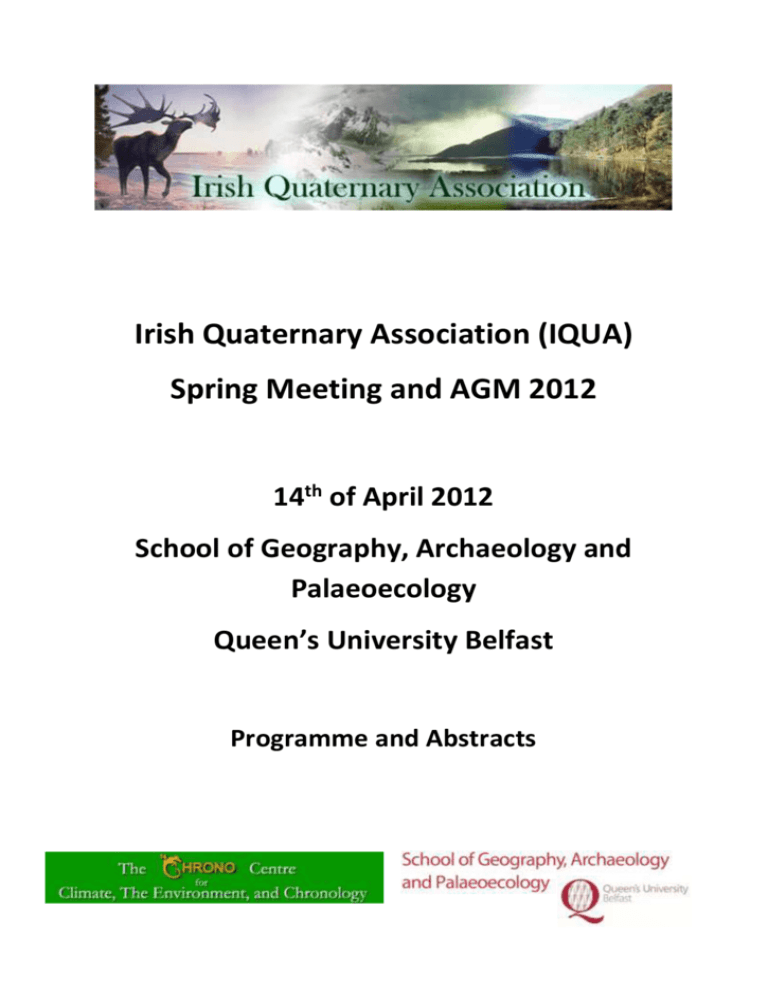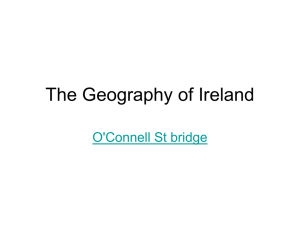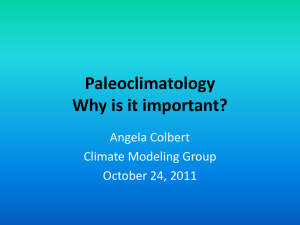docx - IQUA
advertisement

Irish Quaternary Association (IQUA) Spring Meeting and AGM 2012 14th of April 2012 School of Geography, Archaeology and Palaeoecology Queen’s University Belfast Programme and Abstracts IQUA Spring Meeting and AGM 2012 Programme 9.30 am Registration. 10.00 am Welcome to the 2012 IQUA Spring Meeting and AGM. 10.10 am Maarten Blaauw (QUB) Out of tune: the dangers of aligning proxy archives. 10.30 am Gayle McGlynn (TCD) Sediment-based evidence for Holocene environmental change from the Virunga volcanoes in the Albertine Rift, central Africa. 10.50 am Keynote talk: Paula Reimer (QUB) Reliability of radiocarbon dating mollusc shells from Irish sites. 11.10 – 11.30 am Coffee/Tea 11.30 am Karen Taylor (NUIG) Ecological impacts of early farming in western Ireland: a palaeolimnological approach. 11.50 am Michael Dempster (UU) A geochemical approach to glacial sediment provenance in Northern Ireland. 12.10 am Michelle McKeown (NUIG) An assessment of recent climate change and ecological response in NW Ireland using chironomid-based palaeolimnological reconstructions. 12.30 am Kate Johnson (QUB) Investigating late-glacial and Holocene environmental change in South America using phylogenetic and palaeoecological techniques. 12.50 – 1.50 pm Lunch 1.50 pm Sara Benetti (UU) The offshore flow of the British-Irish Ice Sheet recorded by buried and exposed glacial features on the western Irish shelf. 2.10 pm Joyce Novak (MIC) An Examination of Four Vibrocores from Galway Bay – Preliminary Results. 2.30 pm Rory Flood (QUB) Sedimentary processes and provenance of the West Bengal Sundarbans: results and interpretations of facies dynamics. 3.00 pm Annual General Meeting – all welcome Poster Presentations Reconstructing the last Newfoundland Ice Sheet through the last glacial cycle (~28ka10ka yr BP) - Maureen McHenry and Paul Dunlop A large glacio-tectonic raft of Carboniferous Limestone in Killala Bay, Co. Mayo – Michael Philcox Presentation Abstracts Out of tune: the dangers of aligning proxy archives Maarten Blaauw School of Geography, Archaeology and Palaeoecology, Queen’s University Belfast Email: maarten.blaauw@qub.ac.uk Abstract Tuning is a widespread technique to combine, date and interpret multiple fossil proxy archives through aligning supposedly synchronous events between the archives. The approach will be reviewed by discussing a number of literature examples, ranging from peat and tephra layers to orbital tuning and δ18O series from marine and ice deposits. Potential problems will be highlighted such as the dangers of circular reasoning and unrecognised chronological uncertainties, and some solutions suggested. Fossil proxy research could become enhanced if tuning were approached in a more quantitative, reliable and objective way, and especially if individual proxy archives were non-tuned and kept on independent time-scales. Sediment-based evidence for Holocene environmental change from the Virunga volcanoes in the Albertine Rift, central Africa Gayle McGlynna*, Scott Mooneyb and David Taylora a Discipline of Geography, School of Natural Sciences, Trinity College, University of Dublin, Dublin 2, Ireland. b School of Biological, Earth and Environmental Sciences, The University of New South Wales, Sydney 2052 NSW, Australia. * Email: mcglyng@tcd.ie Environmental changes in the Albertine Rift, including the effects of both long-term climate change and human activity, post a potentially serious risk in one of the world’s most biodiverse areas. This study presents new well-dated sedimentary pollen and charcoal evidence from two high-altitude crater sites in the Virunga volcanoes, a group of mountains associated with the Albertine Rift: a ca. 8000-year record from a crater swamp at an altitude of 3474 m, and a ca. 2800-year record from a crater lake at an altitude of 4127 m. Sediment-based evidence from the two crater sites shows that climate changes linked to variations in monsoonal activity during the mid-Holocene were an important driver of vegetation changes, both at high-altitude sites and more widely in adjacent parts of the Albertine Rift, with impacts apparently amplified by concurrent changes in fire regimes. An asynchronous timing of vegetation changes highlights the differential lag effects of responses of plant taxa to climate variability. Human-induced environmental change in the Albertine Rift is apparent only within the last millennium, despite the long history of human occupation of the area. Both study sites record significant forest clearance at ca. 900 cal yrs BP, involving a reduction in lower montane forest taxa and increases in disturbance indicators. Other significant changes in the upper montane forest, possibly linked to anthropogenic changes in the fire regime, are also apparent from ca. 900 cal yrs BP. Human-induced environmental modification from the early part of the last millennium, likely associated with onset of the Late Iron Age, appears to have extended to high altitudes, which were previously assumed to be pristine. The role of natural, long-term climate change as a major cause of environmental change in the Albertine Rift has been eclipsed within the last millennium by human-induced environmental effects, and this has implications for current conservation strategies. Reliability of radiocarbon dating mollusc shells from Irish sites P.J. Reimera*, G. J. McCleanqa,b, D. W. Beilmana,c and S. E. Crowa,c. a School of Geography, Archaeology and Palaeoecology, 14CHRONO Centre for Climate, the Environment & Chronology, Queen's University Belfast, Belfast, BT7 1NN, UK. b School of Geosciences, University of Edinburgh, Edinburgh EH9 3JW, UK. c Department of Geography, University of Hawai’i at Manoa, Honolulu, HI 96822, USA. * Email: p.j.reimer@qub.ac.uk Marine mollusc shells are frequently found in coastal and glacial deposits as well as archaeological sites throughout Ireland. Our ability to reliably use radiocarbon dates of mollusc shells to estimate calendar ages depends in part on the feeding preference and habitat of the particular species and the geology of the region (Mangerud, 1972). Marine mollusc shells are formed primarily from dissolved inorganic carbon (DIC) in seawater but in some species a portion of metabolic carbon is incorporated into the shell (Tanaka et al. 1986). Gastropods which graze on algae living on carbonate rocks are particularly prone to incorporation of carbon from the substrate into their shells (Dye et al. 1994). Measurements of mollusc shells and flesh collected live on limestone and basalt on the east and west coasts of Ireland indicate there is no substrate carbonate incorporated into the shells of the limpets (Patella sp.) but raise doubts about the reliability of periwinkles (Littorina littorea) for radiocarbon dating. The results will have an important consequence for radiocarbon dating of geological and archaeological deposits as well as the bones of humans and animals who fed on the molluscs. References: Dye, T., 1994. Apparent ages of marine shells: implications for archaeological dating in Hawai'i. . Radiocarbon 36: 51-57. Mangerud, J., 1972. Radiocarbon dating of marine shells, including a discussion of apparent age of Recent shells from Norway. Boreas, 1: 143-172. N. Tanaka, M. C. Monaghan, and D. M. Rye, Nature 320, 520 (1986) Ecological impacts of early farming in western Ireland: a palaeolimnological approach Karen Taylor Department of Geography, NUI Galway Email: karen.jantaylor@hotmail.com Abstract This research provides an insight into both the effects and intensity of Neolithic and Bronze Age farming practices through a multi-proxy analysis of a lake sediment core from northwest Ireland. Palaeoenvironmental proxy evidence includes chironomid and stable isotopic analysis of carbon and nitrogen (δ13C, δ15N, and C:N). These proxies were successful in detecting various prehistoric human impacts in the lake catchment, and will help to inform early farming practices in the region. This study emphasizes the usefulness of chironomids in archaeological research. Results from the chironomid analysis show that the first substantial period of agricultural activity during the Early Neolithic resulted in a temporary shift to more eutrophic lake conditions. The chironomid community then reverted back to its pre-impacted state following a decline in agricultural activity in the Middle to Late Neolithic. Following a second, more intensive, period of agricultural activity in the Late Neolithic/Early Bronze Age, lake trophic status was more permanently altered, even during an agricultural hiatus at the end of the Early Bronze Age to the Middle Bronze Age. This study also provides evidence of possible manuring during the Early Neolithic, as indicated by increased levels of δ15N and decreased levels of δ13C and C:N during this time. Increased sedimentation rate, along with increases in δ13C, δ15N, and C:N, the presence of chironomid taxa indicative of erosion and more eutrophic lake conditions, all point to more intensive land use practices during the Bronze Age. A geochemical approach to glacial sediment provenance in Northern Ireland Michael Dempster1*, Paul Dunlop1, Mark Cooper2, Andreas Scheib3 1 School of Environmental Sciences, University of Ulster, Coleraine 2 Geological Survey of Northern Ireland, Belfast, 3 British Geological Survey, Keyworth * Email: dempster-m1@email.ulster.ac.uk Abstract Reconstruction of flow patterns for the Irish Ice Sheet has traditionally relied heavily on the interpretation of subglacial bedforms, namely ribbed moraines and drumlins. Recent research has demonstrated the interpretation of these landforms may at times be misleading, particularly over small sample areas. Furthermore not all areas of glaciated terrain experienced or retain evidence of a bedforming event. An alternative approach independent of bedform presence is to use geochemistry to establish glacial sediment provenance and hence ice flow direction. This project has used geochemistry of soil developed on till to investigate glacial sediment provenance in Northern Ireland. Principal Component Analysis has been applied to the Tellus Survey soil geochemical database for samples taken on areas of till superficial geology in the region. This approach allows identification of groups of chemical elements that can be linked to likely parent bedrock material for the till. The regional results show glacial transport and that the majority of till deposits in Northern Ireland are closely related to local bedrock, with rapid geochemical changes at lithological boundaries. This suggests till transport rates in this sector of the Irish Ice Sheet were low, with rapid entrainment and low evacuation rates of debris to the ice margin. An assessment of recent climate change and ecological response in NW Ireland using chironomid-based palaeolimnological reconstructions Michelle McKeown Department of Geography, NUI Galway Email: m.mckeown1@nuigalway.ie Abstract As anthropogenic climate warming becomes more apparent, it is important to assess the varying responses to this global phenomenon at the regional level. This paper examines the response of the chironomid community in three small low-mid elevation lakes in NW Ireland to changing summer temperature. Changes in the chironomid community from these sites were compared with a local temperature record dating from 1842. Sediment from all these sites was 210Pb and 14C-dated. Chironomid assemblage data is obtainable at the sub-decadal level. A number of recent studies have examined the effects of recent warming on aquatic ecosystems, and have shown the chironomid community to be particularly responsive to this warming trend. However the bulk of these studies have been on high-elevation or highlatitude lakes, as these sites are known to be particularly responsive to climate change. This study will offer insight into the impact of recent climate change on chironomid communities in lakes situated in mid latitude locations at lower elevations. This approach will further clarify the sensitivity of lake systems to the more subtle, although still evident, warming trends experienced in less extreme locations. Investigating late-glacial and Holocene environmental change in South America using phylogenetic and palaeoecological techniques Kate Johnson School of Geography, Archaeology and Palaeoecology, Queen’s University Belfast Email: kjohnson03@qub.ac.uk Abstract Holocene [ca. 12,000 years before present] climatic and environmental changes have played an important role in the distribution and genetic diversity of modern day vegetation. However, these changes in the Southern Hemisphere remain poorly understood and previous research is sparse and often criticized. Modern day populations of Lomatia hirsuta are disjunct; the species is found in central Argentina and Chile, and Peru and Ecuador but is currently absent from northern Chile. The Araucaria araucana species is currently under threat from human activity such as forest clearance and grazing. The research will utilise chloroplast DNA and microsatellite markers of Lomatia hirsuta and Araucaria araucana to study the pattern of current distribution, coupled with the high-resolution analyses of pollen, charcoal and tephra within two lake sediment cores to investigate the environmental history of this region. It is anticipated that the research will provide insight into: 1) the timing and pattern of shifts in vegetation ecotones; 2) the frequency and regimes of fire in the region; 3) a history of volcanic activity in the region; 4) the post-glacial spread of Lomatia hirsuta, and finally; 5) the potential of combining phylogenetic analysis of Araucaria araucana and palaeoecological techniques to provide a richer understanding of environmental change in a region. The offshore flow of the British-Irish Ice Sheet recorded by buried and exposed glacial features on the western Irish shelf Sara Benetti School of Environmental Sciences, University of Ulster, Coleraine Email: s.benetti@ulster.ac.uk OLEX bathymetric data, the high-resolution multibeam bathymetric and seismic data from the Irish National Seabed Survey and from additional surveys on the Irish continental margin have revealed extensive evidence for past ice sheet advance and retreat across the western Irish continental shelf. These marine geophysical data confirmed that the British-Irish Ice Sheet (BIIS) extended for at least 100-150 km offshore of west Ireland and Scotland onto the continental shelf and left a signature of drumlins, moraines and iceberg scours, both buried and at the seabed. These features provide unequivocal evidence for past extension of the BIIS to the shelf edge, reconfiguration of the ice sheet into a series of lobes during deglaciation, followed by subsequent slow retreat of grounded ice. This talk will present an overview of the buried and exposed glacial features across the western Irish shelf, as well as report on the initial observations on sediment cores collected from these features. An Examination of Four Vibrocores from Galway Bay – Preliminary Results Joyce Novak1*, Catherine Dalton1, Caroline Cusack2 1 Mary Immaculate College, University of Limerick, South Circular Road, Limerick 2 Marine Institute, Oranmore, Co. Galway * Email: joyce.novak@mic.ul.ie Coastal sediment records can be used to track Holocene environmental change; including climate change, sea level rise, freshwater discharge and recent anthropogenic changes. An understanding of past, contemporary and future coastal systems requires temporal datasets that can integrate natural conditions and subsequent human induced deviations. This project is a paleoecological study, utilising the sediment record to link spatial and temporal data for coastal ecosystems and applies their use in the Galway Bay region. A transect of the inner bay silt/clay depositional areas <1.8km from the coast was targeted for core extraction. These sediments are being examined for their physical, chemical and biological properties and their response to bay dynamics, the range of natural variability and responses to unusual events. Sediment records portray amalgamated profiles of the extent of land-based activities, along with sedimentation rates, time marker horizons, geochemical signatures and biological responses represented in fossil assemblages. These assemblages provide an ecological track for further assessment of contemporary and future impacts. This presentation portrays the work completed to date: four Vibrocore samples have been examined and sedimentology, lithology and stratigraphy have been established; fourteen AMS 14C dates have been obtained, ranging from 535±22 to 11,699±41 years BP. On-going investigations include fossil assemblages, biochemical properties, salinity levels and sea-level variation. Based on these investigations, past climatic conditions and environmental change during the Holocene in Galway Bay will be assessed. Sedimentary processes and provenance of the West Bengal Sundarbans: results and interpretations of facies dynamics Rory Flood School of Geography, Archaeology and Palaeoecology, Queen’s University Belfast Email: rflood02@qub.ac.uk Abstract The Sundarbans, situated at the confluence of the River Ganges, Brahmaputra and Hughli serves as the primary habitat for many endangered wildlife species, including the Bengal Tiger. The primary aim of this project is to discern the sources, processes responsible and the rate of sedimentation taking place in this estuarine-deltaic environment. A sedimentary facies analysis approach using the geochemical and sedimentological characteristics (powder x-ray diffraction, x-ray fluorescence and particle size analysis) of three cores retrieved from the south Sundarbans has shown quite distinctive mineralogical assemblages and grain size distributions. The mineralogical results from the three cores examined may represent two distinct pathways of sediment entering the Sundarbans; through the products of weathering in parent rock material introduced allochthonously and through some autogenic clay pedogensis. Particle size analysis has been able to elucidate some of the processes behind sedimentation, in particular the role of tidal ebb and flow factors with the sedimentary sequences in the Sundarbans showing a progressive fining-up from the base to the surface of the cores collected. Radiocarbon (14C AMS) dating has been undertaken in order to constrain some record on the rate of sedimentation taking place. The consensus regarding sedimentation in the Sundarbans has been held that these areas are ‘cut-off’ from a supply of detrital, terrigenous sources of sedimentation. However, the preliminary results developed with this project appear to challenge this assertion and show that there are dynamic, in-situ processes taking place within this system. Reconstructing the last Newfoundland Ice Sheet through the last glacial cycle (~28ka10ka yr BP) Maureen McHenry1* and Paul Dunlop1 School of Environmental Sciences, University of Ulster, Coleraine * Email: mc_henry-m@email.ulster.ac.uk Abstract Ice sheets are an integral part of the global climate system and are recognised as both responding to and driving climatic change. Concerns of instability and increased melting rates observed in contemporary ice sheets and the potential impact of these on global sealevels, has led to a need to establish how ice sheets respond to external forcing over long-time periods. An established methodology is to use the glacial landform record to reconstruct palaeo-ice sheet behaviour which provides critical information on how ice-sheets respond to external forcing through entire glacial cycles. The former Newfoundland Ice-sheet is of particular significance due to its position on the fringes of the North Atlantic and the much larger North American Laurentide Ice Sheet. Analyses of this record can provide new information on wider ice sheet-ocean-atmosphere interactions in this region. The aims of this project are to systematically map the glaciated landscape in Newfoundland using satellite remote sensing and use this data to reconstruct the dynamic history of the former Newfoundland ice sheet during the last glacial cycle. This poster presents the initial results from the mapping programme and shows the distribution of subglacial landforms in eastern Newfoundland which are used to reconstruct the former ice flow pathways. A large glacio-tectonic raft of Carboniferous Limestone in Killala Bay, Co. Mayo Michael Philcox Department of Geology, School of Natural Sciences, Trinity College Dublin Email: mphilcox@tcd.ie Abstract A glacio-tectonic raft complex >400 m long is exposed on the E side of Kilcummin Head. The largest element in the complex is a thrust sheet >300 m long and <14 m thick consisting of interbedded limestone (<1 m) and shaly units (<2 m). The northern 120 m of this thrust sheet is ramped up over a lower sheet of the same beds. Vertical joints in the limestones have locally developed into S-dipping “domino” faults, while the topmost bed of the raft is undeformed (“bookshelf faulting”) reflecting ice-induced northward shear. Glacial striations are orientated N-S. The main thrust sheet is covered by blocky, sandstone-dominant, deglacial-phase diamicts enclosing “floating” rafts <35 m long. The northernmost 70 m of the cliff section consists of a stack sub-horizontal thrust sheets >30 m long. Each consists of a highly deformed shaly unit, capped by a little-deformed limestone, which at the N end forms an enclosing terminal overfold. The extensive sub-horizontal form of these thrust sheets and the absence of listric faults indicate that the thrust sheets were emplaced successively upwards, not as piggy-backs. Northward thrusting of the raft complex is in line with drumlin orientation through the Ox Mountains, but relative timing is unknown.









